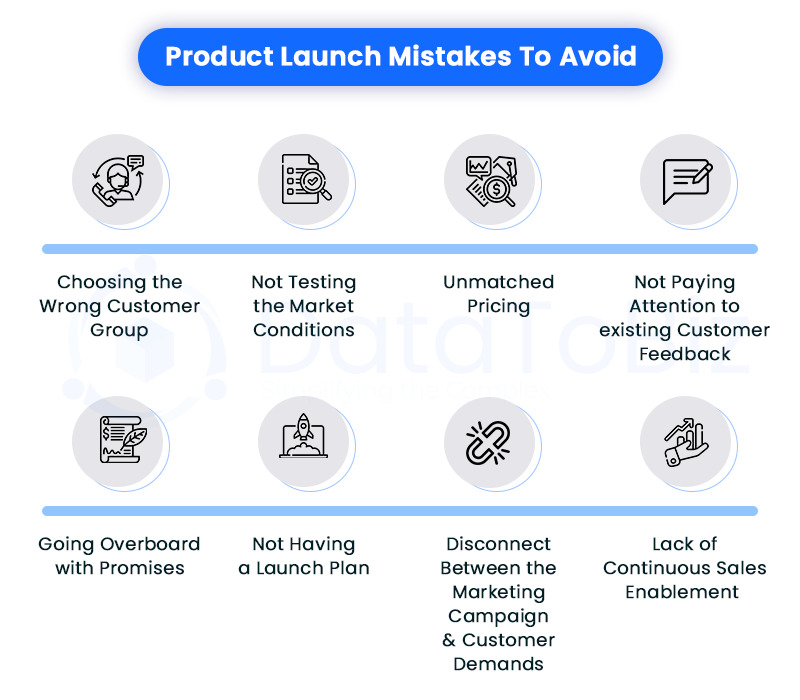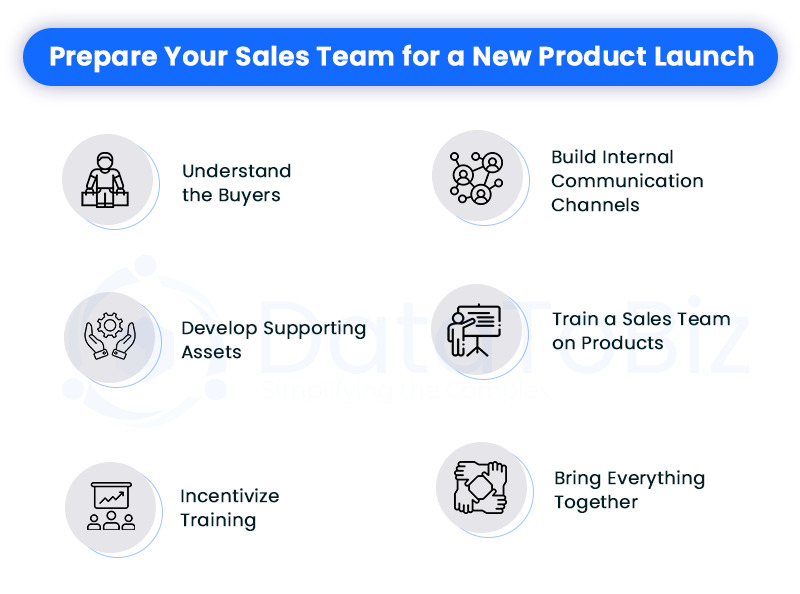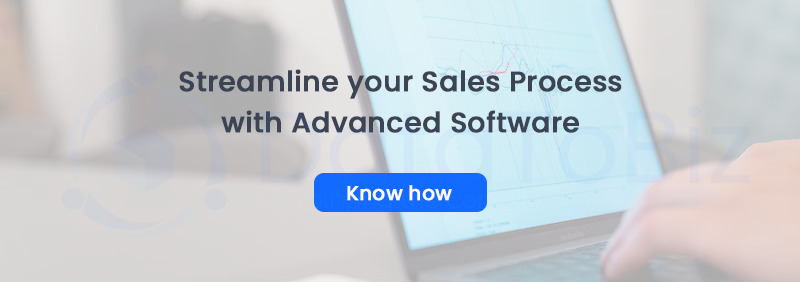Training the sales team before a new product launch is essential to align the marketing campaigns with the product specifications and market demands. We’ll discuss the ways to empower your sales teams for the job at hand.
Launching a new product is a way to attract more customers to a business. However, the organization needs to spend hours of its time for the product to be successful and deliver the desired results. If developing, testing, and launching the product is one aspect, training the sales team to correctly pitch the product to the right market and share important information with the customers is another aspect that requires care and attention.
A worthy product may end up unsuccessful if it is not launched at the right time to the right audiences. But how do you educate your sales team on a new product launch? How do you train them for the task and ensure everything goes the way it should? Are there any mistakes to avoid when launching a new product? Let’s find out.
Product Launch Mistakes to Avoid
It is not easy for the sales team to remember every single point about the new product. Furthermore, they need to be informed about last-minute changes or upgrades. This is added to the information regarding the existing products/services by the business.
In today’s scenario, traditional training methods aren’t enough to empower the sales team. After all, customers demand a lot more from the business, and the responsibility falls on the sales team who directly interacts with the end-users. Providing the sales reps with product launch kits is not enough. They need to know exactly why and how the product will help the target audiences. They should be capable of answering customers’ questions and providing the correct answers.

The following are a few product launch mistakes to avoid:
- Choosing the wrong customer group
- Not testing the market conditions
- Unmatched pricing
- Not paying attention to existing customer feedback
- Going overboard with promises
- Not having a launch plan
- Disconnect between the marketing campaign and customer demands
- Lack of continuous sales enablement
Prepare Your Sales Team for a New Product Launch
The main intent of preparing the sales team for a new product launch should be to take the message correctly and quickly into the target market. They need to spread the word, impress the audience, answer questions, clarify doubts, and convert leads to sales.

This is possible when the sales team is trained to handle the multitude of work efficiently. The representatives should have complete control over the campaigns and effortlessly share the relevant information with the audiences. Here’s how you can create a comprehensive training program for the sales team to successfully launch a new product in the market.
Understand the Buyers
This is the first step you need to take even before preparing the training manual for your sales reps. Why did you create a new product? Who will it help? Why should the target audiences buy the product? What is its USP (Unique Selling Point)? What are the perks of switching to this new product?
These are some questions you need to target when launching marketing campaigns. The sales team cannot design a proper promotional campaign unless it knows the answers to these questions. The sales team should look at the product from the buyer’s perspective to reach out to them. Prepare the training modules to empower the sales reps with the right knowledge about the new product.
Build Internal Communication Channels
Your employees, especially the sales and marketing team members need to be excited about the product launch. Imagine a sales team that doesn’t want to know about the new product. It will provide a generic marketing strategy that may or may not suit the product and its target buyer group. This lack of interest could be different reasons. You must keep them in the loop and ensure that they are equally excited and eager for the launch.
This can be done by building an internal communication channel at least two months before the launch date. Give them the necessary information to think about the product and come up with a suitable campaign. Have team meetings every week and discuss the product. You can even use the sales team as beta customers to test the product and share feedback.
Ensure that their queries related to the product are addressed by the right person. Double-check that the sales reps understand the new product, its features, and its benefits. Keep the excitement alive at the workplace.
Develop Supporting Assets
Supporting assets are different from training modules. These are provided to the sales reps not only during the training period but throughout. Product walkthroughs, sales playbooks, talk tracks, etc., are some examples of supporting assets that help the sales team have access to information about the new product.
The purpose of supporting assets is to guide the sales team at every stage of the sales cycle to amplify returns and make the new product successful. The assets need to be updated as and when there is a change made to the product. Since the sales reps will repeatedly rely on these tools, it is crucial to provide them with the latest and most accurate information.
Train a Sales Team on Products
We have already highlighted the importance of adopting the buyer-centric mindset when launching and promoting a new product. The training materials and programs should align with this and enable the sales teams to think and act like a buyer. At the same time, the sales team should have confidence in their skills and knowledge to take the product to the target market.
A combination of training programs works best to create a comprehensive approach to boost the confidence of the sales reps and increase their efficiency. Move on from the traditional methods and adopt the latest techniques for better results.
Training Methods to Prepare the Sales Team
Webinars
Visual training is the way to go when preparing the sales team for a new product launch. No one is interested in reading a thousand pages of descriptions, explanations, and details. Conduct live or recorded webinars with the product development team. Let the developers explain the product directly to the sales team. The managers can step up to detail the business goals so that the sales team will know how to plan the launch campaign. Make the videos easily accessible for the reps to watch anytime.
Video Coaching
Video coaching is an effective way to prepare and test sales teams. Show them videos of the product and ask them to record their own version of it. Let them become a direct seller by explaining the product in a short video.
This method increases retaining capacity and highlights areas of improvement. It will also give you clarity on whether the training material is useful for the sales team or not. Continue this throughout the training period for the reps to perfect their sales pitch. If they can present the best side of the product in fifteen seconds, you can be assured that the product launch will be successful.
Self-Studying Modules
There’s no denying the importance of on-site training. However, you cannot train the sales team forever. They need to work from their side and put in the necessary effort to understand and explore the new product. Create self-studying modules using quizzes, assessments, reference material, and more.
Design Course and Create Assessments
A comprehensive course can train the sales team to gain the necessary technical knowledge. Using online tools like PrepAI makes it easy to streamline the course and conduct periodic assessments to test the team’s understanding of the product.
PrepAI is an artificial intelligence-based question generator that converts the input data into questions. You can create multiple choice questions, fillips, true or false questions, or descriptive questions for the sales reps to answer. You’ll have full control over the questions and can edit them before finalizing the test paper.
Another advantage of using PrepAI is the types of input it accepts. You can upload PDF or MS Word files, import data from PrepAI’s database, convert data from video to text, or copy-paste the content. Generate the questions by choosing the type and difficulty level (easy, medium, hard). Make the necessary changes and save the assessment. Export it as a PDF or Word document. These assessments will tell you how much information the sales reps have retained about the new product.
Role-Playing
Role-playing allows the sales reps to get practical experience selling the product to the customer. The trainers will monitor the sessions and provide feedback for improvements. From body language to tone to presentation, leading, and conclusion of the pitch, you can help the sales teams perfect their roles to take the new product to the target audience.
However, role-playing is enough for product training. It needs to be supported by other methods so that the reps don’t feel overwhelmed when they meet prospective leads in different environments.
Just-in-Time Training and Microlearning
This is a new training method where the sales teams are provided with enough information to deal with the current scenario. Instead of dumping the entire material on the sales team at the start of the training programs, the information is provided to them in installments.
Furthermore, the material is divided into smaller parts and uploaded in various formats to the database or the training software. This allows the reps to access the data whenever they are in doubt. It changes the training methodology from reading first, remembering later to reading when you want to remember.
Incentivize Training
Once you have the training programs in place, it is time to get the sales team on board and encourage them to complete the programs on time. This can be done by providing incentives like prizes, winner tags, gifts, certificates, etc., to employees who successfully clear the training modules. Healthy competition will keep the sales reps interested and excited about the training programs and the product launch. Who doesn’t like to be recognized for its efforts, right?
Bring Everything Together
The last step is the most vital one for a successful new product launch. You need to bring together the above elements cohesively so that it is aligned with the business mission and the long-term goals.
Understand which training method should be used at which stage of the sales cycle to maximize the results. Link the levels, training programs, and processes to prepare the sales team for the final product launch and marketing campaigns.
Conclusion
Educating your sales team for a new product launch requires extensive planning and steady fast implementation. Invest in advanced software and applications to streamline the process. From building internal communication channels to conducting assessments and developing supporting assets, everything has to be synced and aligned to achieve the common goal.
Boost internal collaborations between teams and improve engagement. An excited and capable sales team will ensure a successful product launch and follow through to sustain the momentum.





